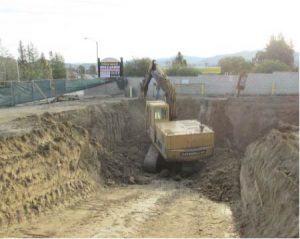 Consideration Should Be Given to Issues Related to Working Around Heavy Equipment:
Consideration Should Be Given to Issues Related to Working Around Heavy Equipment:
- Inspect the equipment prior to operation to ensure that all lights and audible alarms are working properly.
- Establish a defined route and clear visual path for the operator when moving equipment from the point of origin to the work site.
- Set up the equipment at the work area with enough space to allow the equipment and workers to perform the planned tasks.
- Use the three-point mounting and dismounting technique off heavy equipment – NEVER JUMP OFF HEAVY EQUIPMENT.
- Establish a danger zone, that is, a working area where contact could result in personal injury or damage during operations.
- Predefine hand signals or use two-way radios between the operator and person in charge of the work crew to accomplish all movement.
- Maintaining a clear line of sight between the operator and workers blind spots is common, but if you can’t see the operator, he can’t see you.
- Use a spotter when heavy equipment is in motion; this requires communication between the operator and workers to maintain safe movement.
- Always try to walk on the driver’s side of equipment as the passenger side has a larger blind spot.
- Workers should keep a safe distance from all sides of the heavy equipment while it is in use.
- Be aware of the swing radius on certain equipment and, if possible, cordon of the area with barriers or caution tape.
- Wear high visibility clothing and personal protective equipment.
- Never work under a suspended or overhead load.
- Always stay alert.
THOSE WHO PLAN AHEAD USUALLY KEEP A CLOSE WATCH ALL AROUND!!
Download flyer: STOTW_1001-HeavyEquipmentSafety
Download Spanish flyer: STOTW_1001-HeavyEquipmentSafety_esp
 Consideration Should Be Given to Issues Related to Working Around Heavy Equipment:
Consideration Should Be Given to Issues Related to Working Around Heavy Equipment:
